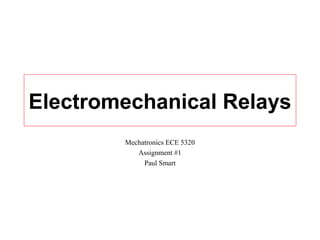Paul smart a
- 1. Electromechanical Relays Mechatronics ECE 5320 Assignment #1 Paul Smart
- 2. Outline âĒ Why Electromechanical Relays? âĒ Common Applications of Electromechanical Relays âĒ The Principle Behind Electromechanical Relays âĒ Whatâs Inside an Electromechanical Relay âĒ Typical Sample Application âĒ Electromechanical Relay Advantages and Limitations âĒ Important Specifications of Electromechanical Relays âĒ Conclusion
- 3. Reference List âĒ http://www.rowand.net/Shop/Tech/AllAboutRelays.htm âĒ http://relays.tycoelectronics.com/schrack/pdf/C0_v4bg_2.pdf âĒ http://www.cutler-hammer.eaton.com/unsecure/html/101basics/Module18/Output/ElectromechanicalRelays.html âĒ http://www.msdignition.com/pdf/8961_8960_msd_relays.pdf âĒ http://zone.ni.com/devzone/conceptd.nsf/webmain/7C83114818EAA85786256DD400569EB7?opendocument âĒ http://www.ibiblio.org/obp/electricCircuits/Digital/DIGI_5.html
- 4. Links To Explore Further âĒ http://www.allegromicro.com/techpub2/phoenix/relay5.htm - Solid State Relays âĒ http://www.ssousa.com/appnote040.asp - Electromechanical Relays vs. Solid State Relays
- 5. Why Electromechanical Relays? âĒ Separation of AC and DC circuits âĒ Interface between electronic control circuits and power circuits
- 6. Common Applications of Electromechanical Relays âĒ Solenoid Activation Control âĒ Many Automotive Applications (Electric Fuel Pump) âĒ Motor Control
- 7. The Principle Behind Electromechanical Relays A relay is similar to a switch, it is either open or closed. When the switch is open no current passes through the relay, the circuit is open, and the load that is connected to the relay receives no power. When a relay is closed, the circuit is completed and current passes through the relay and delivers power to the load. To open and close a relay an electromagnet is used. When the coil controlling the electromagnet is given a voltage, the electromagnet causes the contacts in the relay to connect and transfer current through the relay.
- 8. Electromechanical Relays: Whatâs Inside This diagram shows the basic parts of an electromechanical relay: a spring, moveable armature, electromagnet, moveable contact, and stationary contact. The spring keeps the two contacts separated until the electromagnet is energized, pulling the two contacts together. Moveable Armature Moveable Contact ElectromagnetSpring Stationary Contact
- 9. Wiring Up an Electromechanical Relay Spring To Control Circuit Moveable Armature Moveable Contact Load Power Supply Electromagnet This diagram shows how to wire an electromechanical relay. When the control circuit turns the electromagnet on, the moveable armature is drawn towards the electromagnet and connects the moveable contact and the stationary contact. This completes the circuit and delivers power to the load. Stationary Contact
- 10. Typical Sample Application Suppose, there is a need to control a solenoid valve for a water drain application. Control is to be accomplished with a microcontroller. The solenoid valve requires 120 VAC to open. Assuming that a 120 VAC power supply is available, how can control of the solenoid valve be accomplished using a microcontroller that can only supply 5 VDC? This problem is easily solved using a relay. There are many relays that are turned on and off with a 5 VDC coil. The relay provides the interface between the microcontroller and the 120 VAC power supply that is needed to open and close the valve.
- 11. Typical Sample Application 120 VAC Ground To Microcontroller Solenoid Valve Relay Coil Circuit for Control of a 120 VAC Solenoid Valve
- 12. Electromechanical Relay Advantages âĒ Contacts can switch AC or DC âĒ Low initial cost âĒ Very low contact voltage drop, thus no heat sink is required âĒ High resistance to voltage transients âĒ No Off-State leakage current through open contacts
- 13. Electromechanical Relay Limitations âĒ The contacts wear and thus have limited life depending on loads âĒ Short contact life when used for rapid switching applications or high loads âĒ Poor performance when switching high inrush currents âĒ Package Size
- 14. Important Specifications of Electromechanical Relays âĒ Coil Voltage â Voltage required for switching âĒ Contact Rating â How much current the relay can handle âĒ Normally Open (NO) or Normally Closed (NC)
- 15. Conclusion Electromechanical relays are an excellent solution to separate electronic control circuitry and power circuitry. Electromechanical relays are not the best choice in high frequency switching applications and do have a limited life due to wear on the contacts inside the relay. When used in the a proper application, the electromechanical relay provides safe and reliable integration between power circuits and control circuits.















